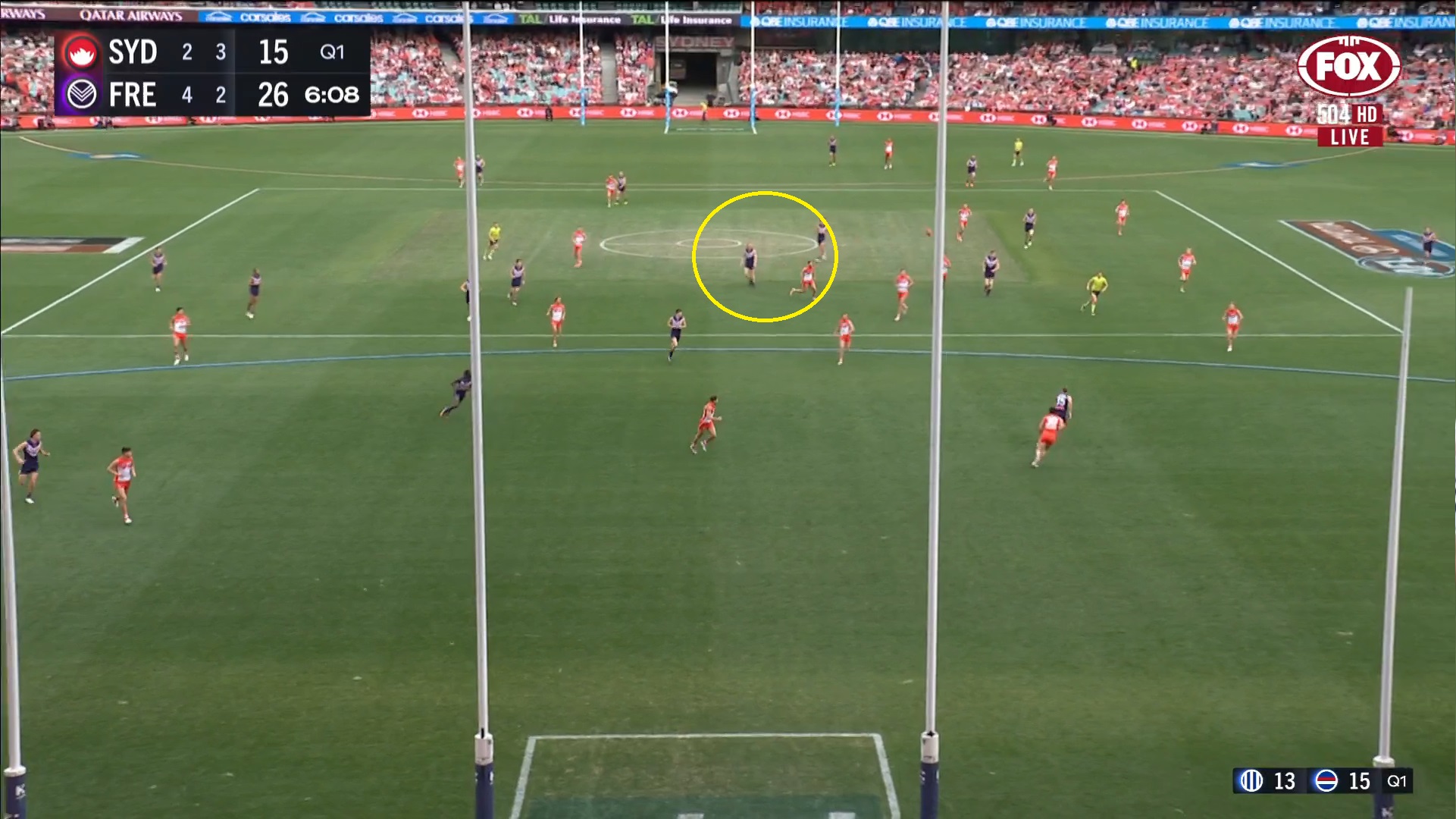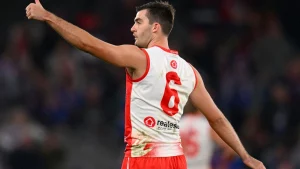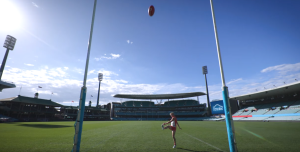Anyone can contribute to The Roar and have their work featured alongside some of Australia’s most prominent sports journalists.
In 2023, amid a wretched start to a season that began with high expectations, the Dockers headed to the SCG to face a reigning grand finalist in Sydney, were given little chance… and stormed the house for another famous win in what became a forgettable season.
Put them together and what have you got? You have what Freo did to the Swans on their own turf on Saturday afternoon, quite easily, for a myriad of reasons, the best victory by any team this season.The eye test tells you that the Swans were off, that their swathe of star on-ballers collectively performed at well below their brilliant best, that their usually watertight backline faltered badly under the strain of repeat entries, that their forward line spurned its chances to end with four more scoring shots and a losing total; and yet they would have at least had a share of the points if Logan McDonald hadn’t horribly muffed his kick after the siren.
But that does the Dockers a disservice.
The reason Chad Warner, Isaac Heeney, Errol Gulden and even Brodie Grundy were well down on their usual output was because Justin Longmuir had a plan for each of them, and his troops executed it brilliantly.
The reason the Swans’ backline was as fragile as it has looked all season long is because Longmuir threw something different at them, with electric, aggressive ball movement and a beautifully spread arrray of marking forward options that each proved a handful in the air.
And the reason the forward line spurned chances is because of Freo’s frenetic, all-consuming pressure, all the more necessary for the absence of their backline lynchpin in captain Alex Pearce, denying the Swans’ best ball users space with which to work their usual magic, blocking off the corridor and making the best team of the season work twice as hard as they have all year to score.
All of the above is why this is, by some distance, the best win of 2024. Longmuir’s Dockers came to the SCG with a dream, and left with a blueprint for how the Swans can be made to look mortal if any rival is bold enough to try it themselves.
It’s how many goals the Dockers scored from chains starting in their defensive 50: six goals from seven, to be exact.
That’s a stunning number on two fronts: one, because in a game dictated mostly by conservatism defensively and ferocious pressure forcing turnovers and repeat entries in attack, defensive half scoring isn’t how most teams put on the lion’s share of their points. Only Adelaide – by 0.3 per game – and St Kilda – by a mile – score more from their defensive half than their forward half, while the reigning premiers Collingwood, whose style many teams attempt to mimic due to their flag, are -18.1.
And two: because Freo as a rule don’t play in this way. Their average score from defensive half per game was 33.4 heading into Round 16, ranking them 12th in the league. Typically, their modus operandi is to calmly retain possession – as evidenced by their third-placed ranking in the AFL for marks and the staggering, league-best numbers Luke Ryan has been racking up – stay patient, and look to gain as much territory as possible unless a real opportunity to go through the corridor presents itself, before going long and forcing a stoppage, which is where their handball-happy game kicks in.

Jordan Clark and Fremantle celebrate defeating Sydney. (Photo by Cameron Spencer/Getty Images)
Add to that Freo’s season-high ratio for kicks to handballs – the Dockers’ rate (42.9 per cent of disposals) sat behind only GWS (43.1) in the first 15 rounds, but that figure shot down to 36.9 at the SCG – and John Longmire’s Swans simply did not know what had hit them in the first quarter.
And the clincher? Sydney, heading into the weekend, had given up 23.6 points per game from the opposition’s defensive half in 2024, comfortably the best in the league.
My theory, though, is that this is as much to do with supply and opportunity than it is something about the Swans’ structure specifically. Teams either can’t or won’t attack them in this way, perhaps fearing the damage Sydney can wreak on turnover going the other way and knowing they pay a terrible price with a single errant kick. Otherwise, I can’t explain why the Swans were sixth in the league at conceding rebound 50s going into Round 16, and yet with the fourth-fewest inside 50s against.
So when the Dockers came out with an aggressive short-kicking strategy, targeting the corridor but always willing to move laterally to either wing and open the ground further, never staying still for long, and looking to hit up any of five marking options in attack, the Swans’ backline, which has held firm all season long, did not know what had hit it.
Translating that aggressive movement into goals is the kicker, but the Dockers also had a set-up in attack to maximise every chance they could get.
In Josh Treacy, Luke Jackson and Jye Amiss, Freo have most bases covered when it comes to key forwards; Bailey Banfield and Sam Sturt, too, are mid-sized forwards who are excellent overhead. Together, they are a mobile quintet that had the athletic capabilities to do exactly what Longmuir wanted them to: divide and conquer.
The Swans, unsurprisingly, are the best team in the AFL this year at both rebounding the footy and denying marks inside 50. Their backline is a well-oiled machine with defined roles and players perfectly suited to them, from the key forward stoppers Lewis Melican and Tom McCartin through to the damaging Nick Blakey and the marshal that is Dane Rampe.
Give them a long kick inside 50 and they have all the height they need to kill the ball; present a ball in dispute, and they will mop up and then slingshot away.
Freo and Longmuir knew this, and devised a plan: isolate each of them and see if, together with some snappy, accurate passing, they can be made to be less than the sum of their parts.
Remarkably for having so many true forwards in their team, the Dockers’ quintet never – and I mean NEVER – clogged up each other’s space. Two – and who they were varied all day to keep the Swans on their toes – would regularly push as far up the ground as the wing and half-back to provide another target to kick to, while two more would present on either half-forward flank, with the other set up in the hot spot leading straight up the corridor.
Take a look at the below example, from the first quarter as Hayden Young (whose shift to a more mid-forward role added another superb user to the Dockers’ attacking mix) passes to the leading Josh Treacy.

Note how spread Sydney’s defence is: Rampe, whose spoil has bailed the Swans out so many times across his career, is 30 metres away, minding Amiss, who has led to half-forward and then doubled back, holding his width from the corridor still. Sturt has pushed up the ground and helped force the contest at half-back that saw the ball end up with Young in the first place; Banfield has held his width on the opposite wing to Amiss.
That left Treacy, one out with McCartin and an open 50 to work with: together with a bullet pass from Young, who had three goal assists for the day, he has the forward craft to double back and take the lead-up mark, then convert.
The discipline with which the Dockers maintained this structure was remarkable, and utterly pivotal to how they sliced up the Swans’ back six with seven goals from 16 inside 50s in the opening term. Freo’s 14 marks inside 50, 11 by half time, is also the equal-most Sydney have conceded all year, as it happens, in no small part due to how isolated each option was.
By full time, all had had their piece of the pie: Amiss took four marks inside 50 and, crucially for his confidence, kicked beautifully; Sturt clunked three to make the most of regular mismatches against smaller Swans defenders; Treacy, who roamed up the ground, had one; as did Jackson and Banfield.
Their disposal heat maps are the proof of the pudding: first, Jackson’s…

… shows he spent most of his time on the broadcast side wing at half-forward when not chopping out Darcy in the ruck, while Amiss…
… instead led to the opposite half-forward flank when inside 50, but when up the ground (usually when Jackson was off or in the ruck) pushed up to the broadcast wing. Meanwhile, Treacy…

… controlled the corridor but also roamed a little freer than the others, though just one of his four marks came inside 50.
Next, Sturt…

… was either well up the ground providing an option, or stationed closer to goal than Amiss or Jackson; often the Dockers would use it as a trap, drawing the Swans’ big key talls out of the zone with leads from that latter duo to allow the smaller but still damaging overhead Sturt to capitalise on a mismatch.
And lastly, Banfield…

… played a selfless role, pushing up hard to both wings but otherwise by and large maintaining his width and drawing a defender, as evidenced by just seven disposals.
Each player has a different zone: Treacy in the central corridor, Sturt near the goalsquare, Amiss and Jackson on opposite flanks. They owned their space, they led hard into their area, they divided the Swans’ defence, and the fruits of their labour were 15 goals of which all contributed.
And that’s without even mentioning the smaller, quicker Michael Frederick and Sam Switkowski, lethal when the ball hit the ground and covering a huge amout of territory sprinting upfield and then back to catch their opponents on the hop.
The same meticulous detail was applied to the Dockers’ plans to nullify the Swans’ all-conquering on-ball brigade, beginning with Grundy.
Usually, the Dockers split the ruckwork fairly evenly between Darcy and Jackson. Not today: attending 26 of 33 centre bounces, Darcy had his second-highest attendance rate of the season, ahead of only Round 15 against Gold Coast. The reason? He was to tag Grundy.
As a matter of fact, this was the first time since the Swans’ loss to Richmond that Grundy has lost the hitout count: only Richmond’s Toby Nankervis of regular rucks has a higher ruck contest win percentage than his 45.2 per cent. Combine that with being fourth-best in the AFL at hitouts to advantage rate, and third for amount, and the Swans have been getting first use all season long.
Not today – and with just one clearance, Grundy was effectively nullified as a follow-up stoppage winner by Darcy’s belligerence.
On a wing, Jeremy Sharp did a number on Gulden in the first half, guarding him closely so as to deny the Swans the chance to go through him as they progressed forward.
But the most impressive part of it was that, at stoppages at least, the Dockers’ biggest goal was not to deny them the footy, but to deny them dangerous space.

The Fox Footy commentators noted at the above stoppage Gulden seemingly being set free: but as it unfolds, Jaeger O’Meara, his opponent, remains goal side of the star Swan and – and this is key – guarding his left foot if he’d ever doubled back.
Gulden does win the footy here, but running away from goal rather than towards it with O’Meara guarding his rear, he’d have to produce something spectacular to do anything with it.
So instead, he handballs backwards to the less precise Ollie Florent, hoping to run inboard, burn O’Meara off and straighten up after he gets the handball receive.

Freo’s teamwork, though, is on point: with O’Meara unable to impact any more, having done his job and forced Gulden back, up comes Treacy into frame to converge on Gulden. His presence is enough to convince Florent he can’t safely give back to their best kicker inside 50, so he instead does exactly what Freo want him to: bomb long to a contest. Even without Pearce, it can be safely nullified.
A similar strategy was employed to combat Warner: both by keeping the ball in tight at as many stoppages as possible until it could be extracted on their terms, and in the Dockers’ structure with the footy in dispute.

Frequently, that task fell to Matthew Johnson, and his positioning at the above bounce is great: goal side of Warner, just as O’Meara was with Gulden, he forces the Chad to either retreat or risk taking him on and being caught.
Warner instead dashes backwards, into free space, and handballs to an oncoming teammate, in the process allowing Freo precious seconds to flood numbers behind the ball, get their zippy half-forwards in Frederick and Switkowski involved to pressure, and put Sydney on the back foot.
The league’s best aggressors have had their wings clipped.
It was Nat Fyfe who, by and large, took responsibility for Heeney at stoppages, with the Dockers champion’s strength and ball-winning nous leaving the Brownlow Medal favourite with scarcely an inch of his own space.
Adept at jostling, Fyfe never gave Heeney a moment’s peace; where he and James Rowbottom usually do the blocking work at stoppages to allow Warner and Gulden free space to roam in, now they were copping a taste of their own medicine, with the brilliant Caleb Serong the most prolific ball-winning threat.
The moment Longmire moved James Jordon, who had tagged Jordan Clark successfully once again in the first half, on ball to clamp Serong at half time, was the greatest sign of all of Freo’s tactical mastery.
The last player to force Longmire into this drastic action was Western Bulldog Ed Richards, whose concussion just after half time of their Round 11 clash allowed the Swans to quickly push Jordon out of the midfield rotation and back into his primary role as a half-forward clamping the opposition’s best running small defender.
Serong was certainly quieter after half time, while Heeney, the man most often pushed out, had an impact further afield: the changes definitely worked for Longmire and allowed the Swans to come home hard in the second half.
But the fact they were needed at all is a shock in itself. Sydney’s Plan A has been so devastating this year that rarely have they ever had to change tacks, to go defensive.
The Dockers, though, made it inevitable: the below centre bounce extraction serves as proof.
It’s clamping your enemies’ strengths and capitalising on their weaknesses. It’s how you beat an unstoppable juggernaut on their home patch.
It was this which let Freo surge to a five-goal lead early in the second half; from there, it was just about hanging on. Which they did – just.
The Swans have had down patches in games of late, to be sure; but this is the first time they have been thoroughly tactically outclassed. It was nothing short of a masterpiece from Longmuir.
It takes some serious balls for a coach to change his team’s usual modus operandi, and superb flexibility from his team to pull it off.
The reward? Four premiership points and third on the ladder. At this stage of the season, with the competition for spots in the eight so fierce, there are few prizes greater.



